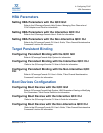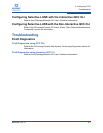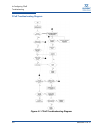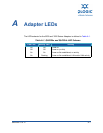
SN0054671-00 A Glossary-3
User’s Guide Converged Network Adapter
8200 and 3200 Series Adapters
logical unit number (LUN)
A subdivision of a SCSI target. It is the
small integer handle that differentiates an
individual disk drive or partition (volume)
within a common SCSI target device such
as a disk array.
Technically, a LUN can be a single
physical disk drive, multiple physical disk
drives, or a portion (volume) of a single
physical disk drive. However, LUNs are
typically not entire disk drives but rather
virtual partitions (volumes) of a RAID set.
Using LUNs, the Fibre Channel host can
address multiple peripheral devices that
may share a common controller.
loopback
Diagnostic tool that routes transmit data
through a loopback connector back to the
same adapter.
message signaled interrupts (MSI/MSIX)
One of two PCI-defined extensions to
support message signaled interrupts
(MSI), in PCI 2.2 and later and PCIe. MSIs
are an alternative way of generating an
interrupt through special messages that
allow emulation of a pin assertion or
deassertion.
MSI-X (defined in PCI 3.0) allows a device
to allocate any number of interrupts
between 1 and 2048 and gives each inter-
rupt separate data and address registers.
Optional features in MSI (64-bit
addressing and interrupt masking) are
mandatory with MSI-X.
network interface controller/card (NIC)
A computer circuit board or card that is
installed in a computer so that it can be
connected to a network.
node port (N_Port)
Node port. A port that connects by a
point-to-point link to either a single N_Port
or a single G_Port. N_Ports handle
creation, detection, and flow of message
units to and from the connected systems.
N_Ports are end ports in virtual
point-to-point links through a fabric, for
example N_Port to F_Port to F_Port to
N_Port using a single Fibre Channel fabric
switch.
node port ID virtualization (NPIV)
The ability for a single physical Fibre
Channel end point (N_Port) to support
multiple, uniquely addressable, logical end
points. With NPIV, a host Fibre Channel
adapter is shared in such a way that each
virtual adapter is assigned to a virtual
server and is separately identifiable within
the fabric. Connectivity and access privi-
leges within the fabric are controlled by
identification of each virtual adapter and,
hence, the virtual server using each virtual
adapter.
Nonvolatile random access memory
(NVRAM)
A type of memory that retains data (config-
uration settings) even when power is
removed. You can manually configure
NVRAM settings or restore them from a
file.
path
A path to a device is a combination of an
adapter port instance and a target port as
distinct from internal paths in the fabric
network. A fabric network appears to the
operating system as an opaque network
between the adapter (initiator) and the
target.


















